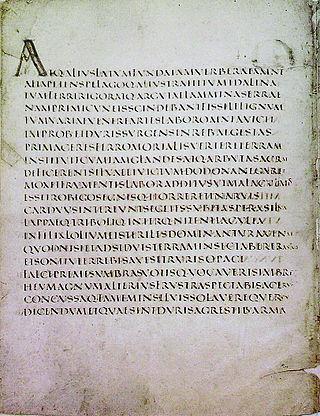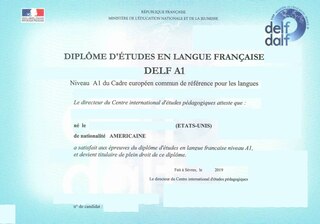Furigana is a Japanese reading aid consisting of smaller kana printed either above or next to kanji or other characters to indicate their pronunciation. It is one type of ruby text. Furigana is also known as yomigana (読み仮名) and rubi in Japanese. In modern Japanese, it is usually used to gloss rare kanji, to clarify rare, nonstandard or ambiguous kanji readings, or in children's or learners' materials. Before the post-World War II script reforms, it was more widespread.

Japanese is the principal language of the Japonic language family spoken by the Japanese people. It has around 123 million speakers, primarily in Japan, the only country where it is the national language, and within the Japanese diaspora worldwide.
Katakana is a Japanese syllabary, one component of the Japanese writing system along with hiragana, kanji and in some cases the Latin script.

Kanji are the logographic Chinese characters adapted from the Chinese script used in the writing of Japanese. They were made a major part of the Japanese writing system during the time of Old Japanese and are still used, along with the subsequently-derived syllabic scripts of hiragana and katakana. The characters have Japanese pronunciations; most have two, with one based on the Chinese sound. A few characters were invented in Japan by constructing character components derived from other Chinese characters. After the Meiji Restoration, Japan made its own efforts to simplify the characters, now known as shinjitai, by a process similar to China's simplification efforts, with the intention to increase literacy among the general public. Since the 1920s, the Japanese government has published character lists periodically to help direct the education of its citizenry through the myriad Chinese characters that exist. There are nearly 3,000 kanji used in Japanese names and in common communication.

Scriptio continua, also known as scriptura continua or scripta continua, is a style of writing without spaces or other marks between the words or sentences. The form also lacks punctuation, diacritics, or distinguished letter case. In the West, the oldest Greek and Latin inscriptions used word dividers to separate words in sentences; however, Classical Greek and late Classical Latin both employed scriptio continua as the norm. The scriptio continua is also known as Latin skeleton script.
The Japanese-Language Proficiency Test, or JLPT, is a standardized criterion-referenced test to evaluate and certify Japanese language proficiency for non-native speakers, covering language knowledge, reading ability, and listening ability. The test is held twice a year in Japan and selected countries, and once a year in other regions. The JLPT is conducted by the Japan Foundation for tests overseas, and Japan Educational Exchanges and Services for tests in Japan.

Test of English as a Foreign Language is a standardized test to measure the English language ability of non-native speakers wishing to enroll in English-speaking universities. The test is accepted by more than 11,000 universities and other institutions in over 190 countries and territories. TOEFL is one of several major English-language tests worldwide, including IELTS, Pearson Test of English (PTE), Duolingo English Test, Cambridge Assessment English, and Trinity College London exams.
The Test of English for International Communication (TOEIC) is an international standardized test of English language proficiency for non-native speakers. It is intentionally designed to measure the everyday English skills of people working in an international environment.

The modern Japanese writing system uses a combination of logographic kanji, which are adopted Chinese characters, and syllabic kana. Kana itself consists of a pair of syllabaries: hiragana, used primarily for native or naturalized Japanese words and grammatical elements; and katakana, used primarily for foreign words and names, loanwords, onomatopoeia, scientific names, and sometimes for emphasis. Almost all written Japanese sentences contain a mixture of kanji and kana. Because of this mixture of scripts, in addition to a large inventory of kanji characters, the Japanese writing system is considered to be one of the most complicated currently in use.
The Hong Kong Advanced Level Examination, or more commonly known as the A-level, conducted by the Hong Kong Examinations and Assessment Authority (HKEAA), was taken by senior students at the end of their matriculation in Hong Kong between 1979 and 2012. It was originally the entrance examination in University of Hong Kong until the introduction of the Joint University Programmes Admissions System (JUPAS) in 1992, which made it the major university entrance examination for all local universities until academic year 2011/2012.

Cambridge English: Young Learners, formerly known as Young Learners English Tests (YLE), is a suite of English language tests that is specially designed for children in primary and lower-secondary school. The tests are provided by the Cambridge Assessment English.
The audio-lingual method or Army Method is a method used in teaching foreign languages. It is based on behaviorist theory, which postulates that certain traits of living things, and in this case humans, could be trained through a system of reinforcement. The correct use of a trait would receive positive while incorrect use of that trait would receive negative feedback.
The Test of English Proficiency developed by Seoul National University or TEPS is an English proficiency test created by Seoul National University's Language Education Institute to evaluate South Korean test takers' English language skills. TEPS has been administered nationwide since January 1999. It consists of 200 questions which are divided into four sections: Listening, Grammar, Vocabulary, and Reading. TEPS scores are divided into the ten ratings ranging from 1 + to 5. It is designed to test applicants' communicative English skills and to minimize test-taker reliance on certain strategies such as rote memorization. A study of the test indicated that it is valid and fair.

The Diplôme d'études en langue française or DELF for short, is a diploma of French-language abilities for non-native speakers of French administered by France Education International for France's Ministry of Education. It is composed of four independent diplomas corresponding to the first four levels of the Common European Framework of Reference for Languages: A1, A2, B1 and B2. Above this level, the "Proficient User" divisions are certified by the DALF.
C2 Proficiency, previously known as Cambridge English: Proficiency and the Certificate of Proficiency in English (CPE), is an English language examination provided by Cambridge Assessment English (previously known as Cambridge English Language Assessment and University of Cambridge ESOL examination).
The Test of Proficiency in Korean is a test to measure the Korean language proficiency of non-native speakers in South Korea. This examination system was introduced by the South Korean government in 1997 and conducted by a branch of the Ministry of Education of the country.

The Test of Chinese as a Foreign Language is the Republic of China (Taiwan)'s standardized test of proficiency in ROC Standard Chinese for non-native speakers such as foreign students. It is administered by the Steering Committee for the Test Of Proficiency-Huayu (SC-TOP). The committee is under the direction of Taiwan's Ministry of Education. The test was formerly known as the TOP or Test Of Proficiency-Huayu.

The Deutsches Sprachdiplom der Kultusministerkonferenz (engl.: German Language Certificate of the Education Ministers Conference) is an official German language certificate of the German education authorities and the Foreign Office (Germany) certifying levels of knowledge of the German language in schools worldwide. The program, originally intended to stimulate interest in German, has run since 1973 and, different from the equivalent certificates of the Goethe Institute, is meant for students at officially recognized schools abroad, either Diploma schools or German Schools Abroad. The program prepares the participants for a study in Germany in matters of language and cultural issues. It finishes with an exam and a certification on language competencies on level A2/B1 or B2/C1 of the Common European Framework of Reference for Languages. The certificate together with national school leaving examinations entitles foreign students to apply for university entry in Germany.
A2 Key, previously known as Cambridge English: Key and the Key English Test (KET), is an English language examination provided by Cambridge Assessment English.

The international ECL examination system provides a standardised test-system customised to the languages of the EU member states and the EU candidate countries. The test-system is based on the recommendations of the Common European Framework of Reference (CEFR) and is operated by the European Consortium for the Certificate of Attainment in Modern Languages (ECL). The ECL is an association of institutions representing European languages.








